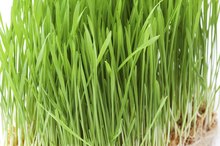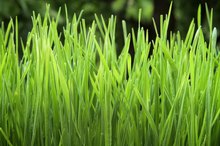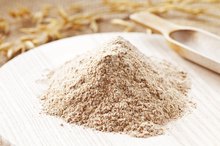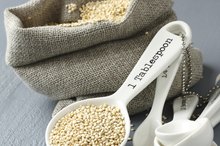Difference Between Wheat & Wheatgrass
Although wheatgrass comes from the same plant that produces the wheat grain used to make flour, wheatgrass is harvested before the plant matures and produces grain.
Wheat Plant
Wheat and wheatgrass come from the same plant, Triticum aestivum. The term "wheat" generally refers to the grain often used to make flour, while "wheatgrass" refers to the young grass that grows before the grain is produced.
Wheatgrass
Differences Between Wheat Germ & Wheatgrass
Learn More
When the grass is young, before it produces grain, it can be harvested and juiced or dried. Wheatgrass juice is typically served at juice bars or health food stores in "shots" or added to other juice drinks and smoothies. Dried wheatgrass is sold in capsules and as a powder you can add to drinks for health benefits. Some health food stores also sell fresh wheatgrass for juicing at home. The plant is about seven inches high and bright green.
- When the grass is young, before it produces grain, it can be harvested and juiced or dried.
- Wheatgrass juice is typically served at juice bars or health food stores in "shots" or added to other juice drinks and smoothies.
Wheat Grain
The wheat grain -- a small, dry fruit the mature grass produces -- is much more commonly consumed as a staple food worldwide. Whole wheat grain is rich in fiber, B vitamins, vitamin E and minerals such as:
- iron
- zinc
- magnesium
- according to a report from the Minnesota Department of Health
Wheat grains are also fermented to make beer and other alcoholic beverages. After corn and rice, wheat is the most consumed cereal in the world.
Reasons to Consume Wheatgrass
Wheatgrass & Weight Loss
Learn More
Wheatgrass contains vitamins A and C, protein, zinc and other vital nutrients in a concentrated form. It also contains chlorophyll, the green pigment found in most plants. Consumption of chlorophyll is proposed to have a number of health benefits, including strengthening the heart and lungs and detoxifying and purifying the body. Wheatgrass may also help alleviate the symptoms of ulcerative colitis, according to New York University's Langone Medical Center 3.
- Wheatgrass contains vitamins A and C, protein, zinc and other vital nutrients in a concentrated form.
- Consumption of chlorophyll is proposed to have a number of health benefits, including strengthening the heart and lungs and detoxifying and purifying the body.
Wheat Allergies and Wheatgrass
Because wheatgrass contains no wheat grains, those who suffer from wheat allergies, celiac disease or gluten intolerance can safely consume wheatgrass juice and powder. This is because an allergy to wheat is most often an allergy to gluten, a component of the grain. Wheatgrass does not contain gluten and is therefore not likely to cause an adverse reaction.
Related Articles
References
- Illinois State University Extension: Wheat Grass
- American Cancer Society: Wheatgrass
- NYU Langone Medical Center: Wheat Grass Juice
- Wheat grass powder. FoodData Central. U.S. Department of Agriculture. Published April 1, 2019.
- Renu M, Preeti R. Health benefits of wheat grass — a wonder food. Int J Food Nutr Sci. 2013;2(4):10-13.
- Bar-Sela G, Cohen M, Ben-Arye E, Epelbaum R. The medical use of wheatgrass: Review of the gap between basic and clinical applications. Mini Rev Med Chem. 2015;15(12):1002-10. doi:10.2174/138955751512150731112836
- Wan P, Chen H, Guo Y, Bai AP. Advances in treatment of ulcerative colitis with herbs: From bench to bedside. World J Gastroenterol. 2014;20(39):14099-104. doi:10.3748/wjg.v20.i39.14099
- Bar-Sela G, Tsalic M, Fried G, Goldberg H. Wheat grass juice may improve hematological toxicity related to chemotherapy in breast cancer patients: A pilot study. Nutr Cancer. 2007;58(1):43-8. doi:10.1080/01635580701308083
- Kyada A, Chorai P. Myeloprotective effect of Triticum aestivum Linn. grass against antineoplastic agents induced bone marrow toxicity in mice. Trends in Pharmaceutical Sciences. 2017;3(3):169-180.
- Kothari S, Jain AK, Mehta SC, Tonpay SD. Hypolipidemic effect of fresh Triticum aestivum (wheat) grass juice in hypercholesterolemic rats. Acta Pol Pharm. 2011;68(2):291-4.
- Mutha AS, Shah KU, Kinikar AA, Ghongane BB. Efficacy and safety of wheat grass in thalassemic children on regular blood transfusion. Cureus. 2018;10(3):e2306. doi:10.7759/cureus.2306
- Parit SB, Dawkar VV, Tanpure RS, Pai SR, Chougale AD. Nutritional quality and antioxidant activity of wheatgrass (Triticum aestivum) unwrap by proteome profiling and DPPH and FRAP assays. J Food Sci. 2018;83(8):2127-2139. doi:10.1111/1750-3841.14224
- Wheat grass cold pressed juice. FoodData Central. U.S. Department of Agriculture. Published April 1, 2019.
Writer Bio
Sheila Zahra began working as an editor and writer in 2004. She has edited full-length works of fiction and nonfiction, and has written articles and essays for academic and business clients. Zahra earned a Bachelor of Arts in English literature and creative writing from California State University, Long Beach, in 2006. She currently lives and works in Eugene, Oregon.









